Economics Assignment: Market Analysis, Elasticity, and Trade
VerifiedAdded on 2020/04/07
|17
|605
|132
Homework Assignment
AI Summary
This economics assignment presents solutions to various microeconomic problems. Part 1 analyzes labor market equilibrium, minimum wage effects, and surplus calculations. Part 2 focuses on elasticity of demand, including income and price elasticity, using the midpoint method. Part 3 explores market equilibrium, the impact of international trade, and the effects of tariffs, including consumer and producer surplus changes. The assignment utilizes diagrams to illustrate concepts such as supply, demand, and market dynamics. Overall, the assignment covers core microeconomic principles, providing a comprehensive analysis of market behavior and economic policies.
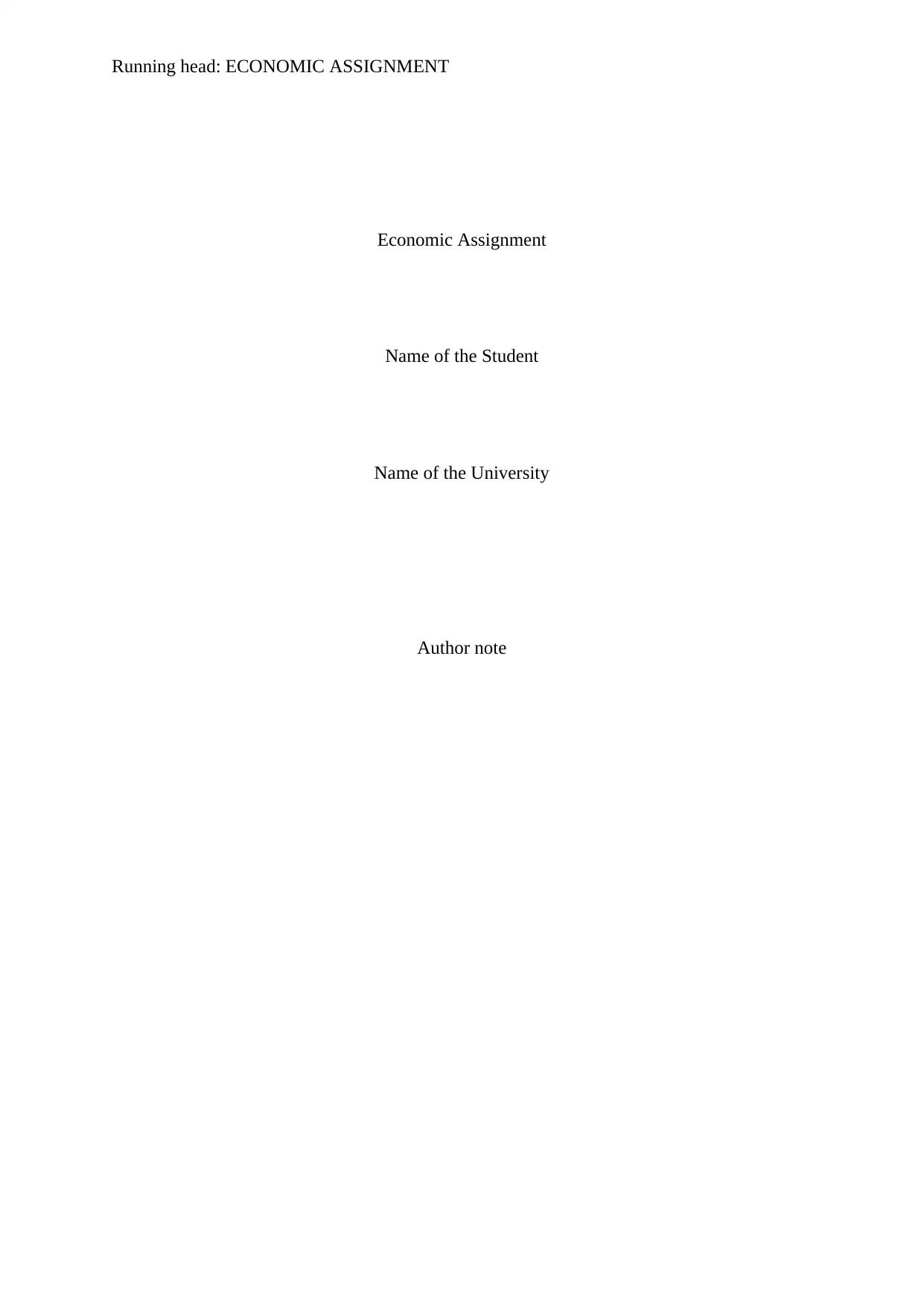
Running head: ECONOMIC ASSIGNMENT
Economic Assignment
Name of the Student
Name of the University
Author note
Economic Assignment
Name of the Student
Name of the University
Author note
Paraphrase This Document
Need a fresh take? Get an instant paraphrase of this document with our AI Paraphraser
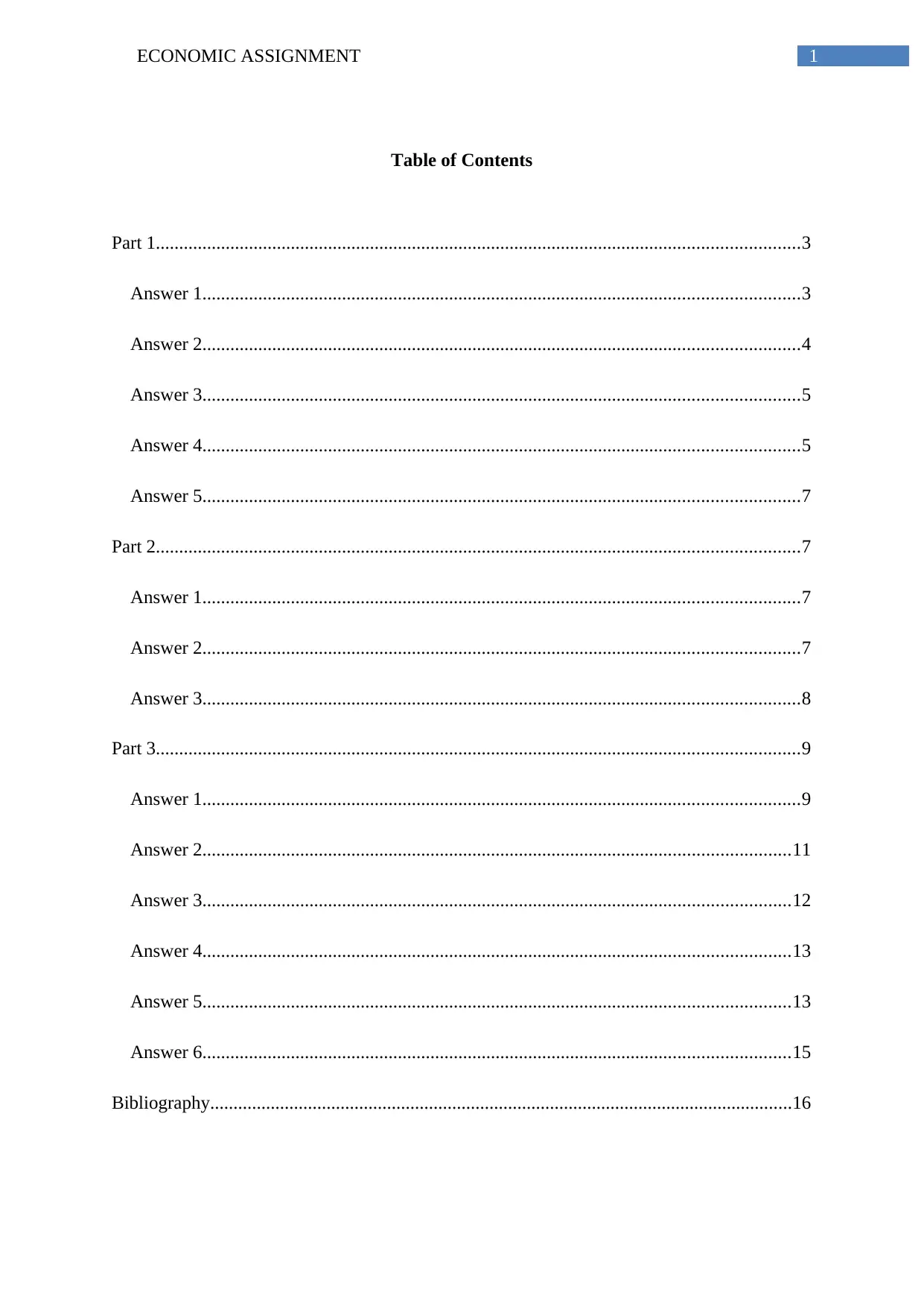
1ECONOMIC ASSIGNMENT
Table of Contents
Part 1..........................................................................................................................................3
Answer 1................................................................................................................................3
Answer 2................................................................................................................................4
Answer 3................................................................................................................................5
Answer 4................................................................................................................................5
Answer 5................................................................................................................................7
Part 2..........................................................................................................................................7
Answer 1................................................................................................................................7
Answer 2................................................................................................................................7
Answer 3................................................................................................................................8
Part 3..........................................................................................................................................9
Answer 1................................................................................................................................9
Answer 2..............................................................................................................................11
Answer 3..............................................................................................................................12
Answer 4..............................................................................................................................13
Answer 5..............................................................................................................................13
Answer 6..............................................................................................................................15
Bibliography.............................................................................................................................16
Table of Contents
Part 1..........................................................................................................................................3
Answer 1................................................................................................................................3
Answer 2................................................................................................................................4
Answer 3................................................................................................................................5
Answer 4................................................................................................................................5
Answer 5................................................................................................................................7
Part 2..........................................................................................................................................7
Answer 1................................................................................................................................7
Answer 2................................................................................................................................7
Answer 3................................................................................................................................8
Part 3..........................................................................................................................................9
Answer 1................................................................................................................................9
Answer 2..............................................................................................................................11
Answer 3..............................................................................................................................12
Answer 4..............................................................................................................................13
Answer 5..............................................................................................................................13
Answer 6..............................................................................................................................15
Bibliography.............................................................................................................................16

2ECONOMIC ASSIGNMENT
⊘ This is a preview!⊘
Do you want full access?
Subscribe today to unlock all pages.

Trusted by 1+ million students worldwide
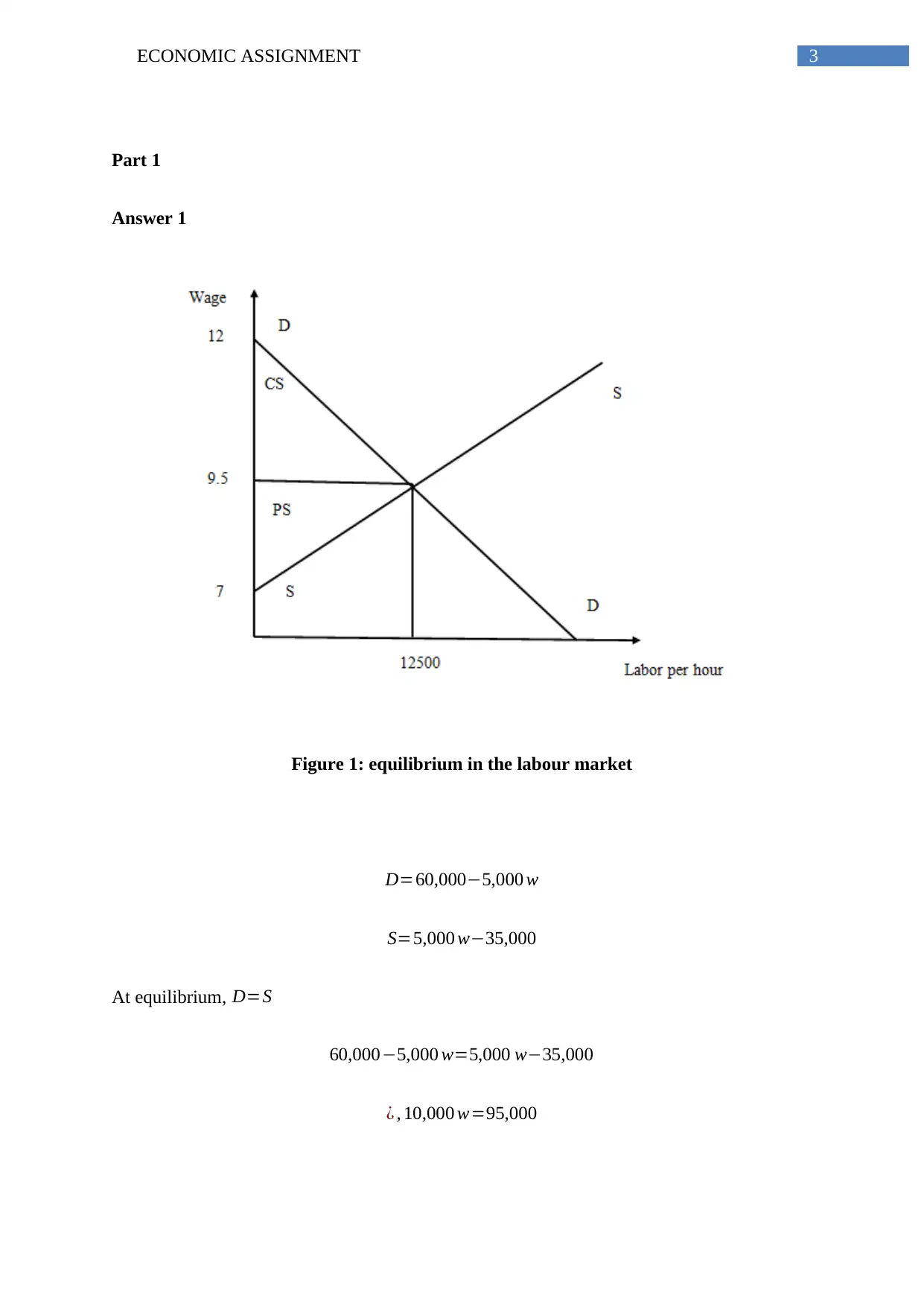
3ECONOMIC ASSIGNMENT
Part 1
Answer 1
Figure 1: equilibrium in the labour market
D=60,000−5,000 w
S=5,000 w−35,000
At equilibrium, D=S
60,000−5,000 w=5,000 w−35,000
¿ , 10,000 w=95,000
Part 1
Answer 1
Figure 1: equilibrium in the labour market
D=60,000−5,000 w
S=5,000 w−35,000
At equilibrium, D=S
60,000−5,000 w=5,000 w−35,000
¿ , 10,000 w=95,000
Paraphrase This Document
Need a fresh take? Get an instant paraphrase of this document with our AI Paraphraser
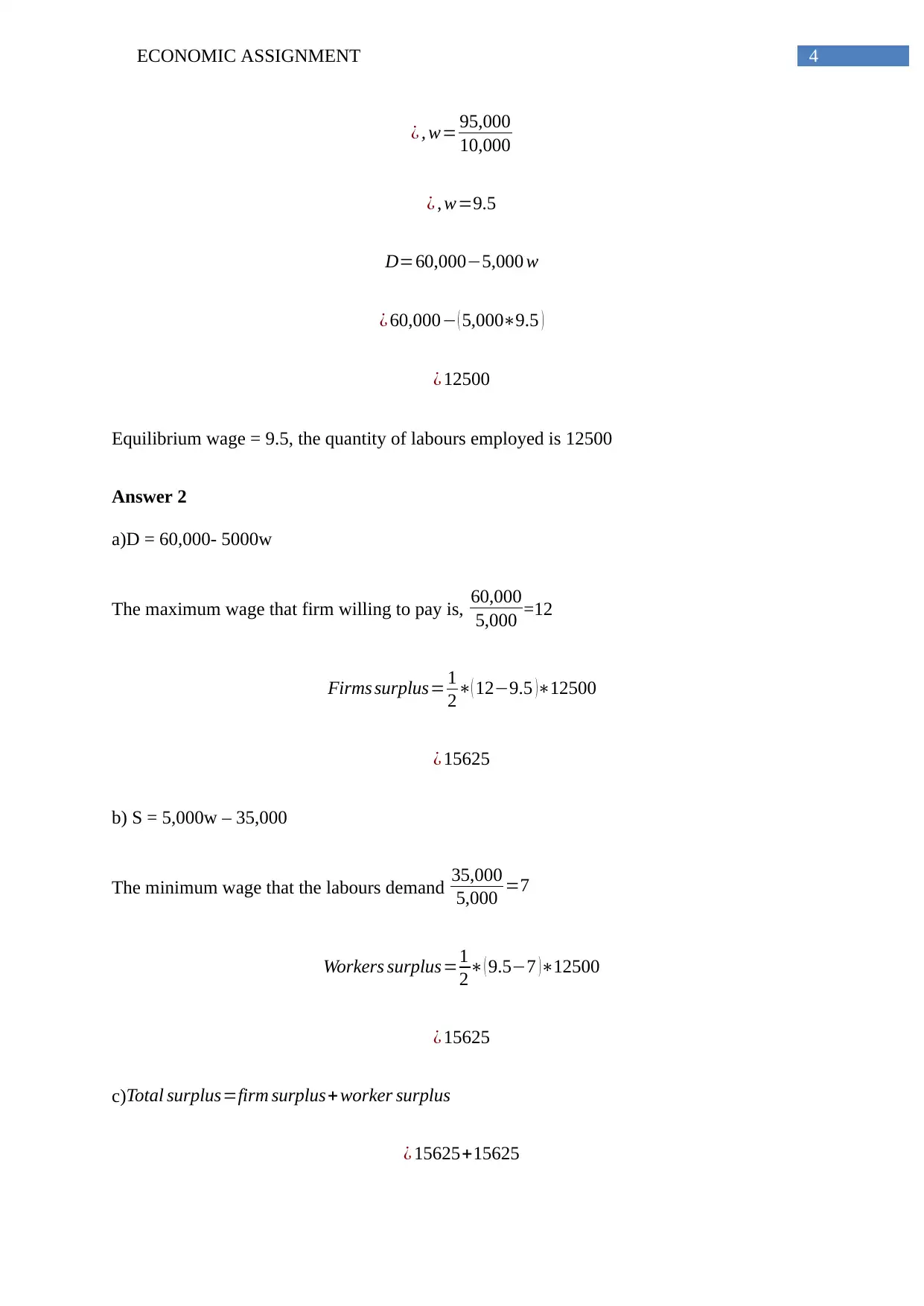
4ECONOMIC ASSIGNMENT
¿ , w= 95,000
10,000
¿ , w=9.5
D=60,000−5,000 w
¿ 60,000− ( 5,000∗9.5 )
¿ 12500
Equilibrium wage = 9.5, the quantity of labours employed is 12500
Answer 2
a)D = 60,000- 5000w
The maximum wage that firm willing to pay is, 60,000
5,000 =12
Firms surplus= 1
2∗( 12−9.5 )∗12500
¿ 15625
b) S = 5,000w – 35,000
The minimum wage that the labours demand 35,000
5,000 =7
Workers surplus=1
2∗ ( 9.5−7 )∗12500
¿ 15625
c) Total surplus=firm surplus+worker surplus
¿ 15625+15625
¿ , w= 95,000
10,000
¿ , w=9.5
D=60,000−5,000 w
¿ 60,000− ( 5,000∗9.5 )
¿ 12500
Equilibrium wage = 9.5, the quantity of labours employed is 12500
Answer 2
a)D = 60,000- 5000w
The maximum wage that firm willing to pay is, 60,000
5,000 =12
Firms surplus= 1
2∗( 12−9.5 )∗12500
¿ 15625
b) S = 5,000w – 35,000
The minimum wage that the labours demand 35,000
5,000 =7
Workers surplus=1
2∗ ( 9.5−7 )∗12500
¿ 15625
c) Total surplus=firm surplus+worker surplus
¿ 15625+15625
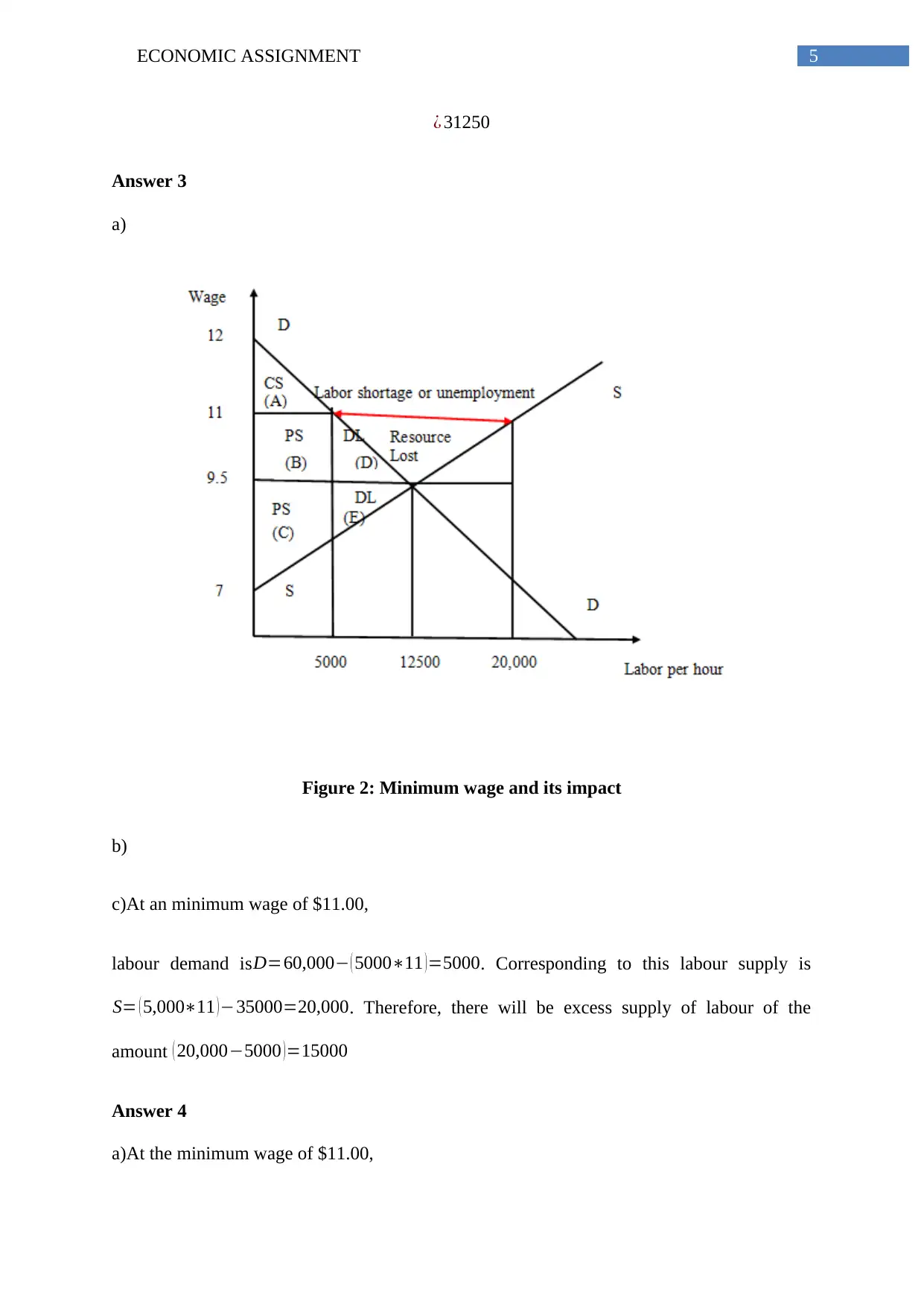
5ECONOMIC ASSIGNMENT
¿ 31250
Answer 3
a)
Figure 2: Minimum wage and its impact
b)
c)At an minimum wage of $11.00,
labour demand isD=60,000− ( 5000∗11 )=5000. Corresponding to this labour supply is
S= ( 5,000∗11 ) −35000=20,000. Therefore, there will be excess supply of labour of the
amount ( 20,000−5000 )=15000
Answer 4
a)At the minimum wage of $11.00,
¿ 31250
Answer 3
a)
Figure 2: Minimum wage and its impact
b)
c)At an minimum wage of $11.00,
labour demand isD=60,000− ( 5000∗11 )=5000. Corresponding to this labour supply is
S= ( 5,000∗11 ) −35000=20,000. Therefore, there will be excess supply of labour of the
amount ( 20,000−5000 )=15000
Answer 4
a)At the minimum wage of $11.00,
⊘ This is a preview!⊘
Do you want full access?
Subscribe today to unlock all pages.

Trusted by 1+ million students worldwide
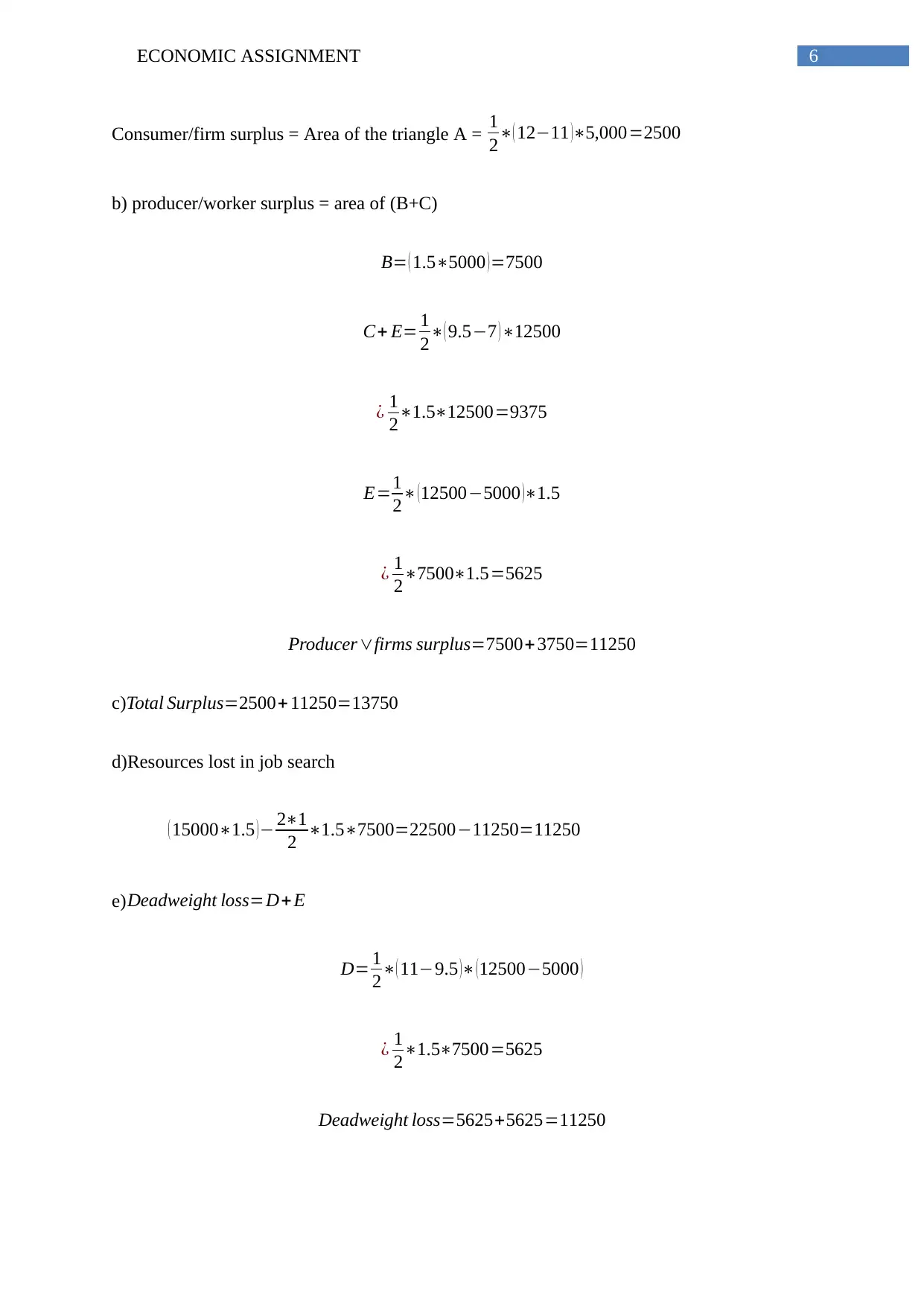
6ECONOMIC ASSIGNMENT
Consumer/firm surplus = Area of the triangle A = 1
2∗( 12−11 )∗5,000=2500
b) producer/worker surplus = area of (B+C)
B= ( 1.5∗5000 )=7500
C+ E= 1
2∗( 9.5−7 )∗12500
¿ 1
2∗1.5∗12500=9375
E=1
2∗ (12500−5000 )∗1.5
¿ 1
2∗7500∗1.5=5625
Producer∨firms surplus=7500+ 3750=11250
c)Total Surplus=2500+ 11250=13750
d)Resources lost in job search
( 15000∗1.5 ) − 2∗1
2 ∗1.5∗7500=22500−11250=11250
e)Deadweight loss=D+ E
D= 1
2∗( 11−9.5 )∗ (12500−5000 )
¿ 1
2∗1.5∗7500=5625
Deadweight loss=5625+5625=11250
Consumer/firm surplus = Area of the triangle A = 1
2∗( 12−11 )∗5,000=2500
b) producer/worker surplus = area of (B+C)
B= ( 1.5∗5000 )=7500
C+ E= 1
2∗( 9.5−7 )∗12500
¿ 1
2∗1.5∗12500=9375
E=1
2∗ (12500−5000 )∗1.5
¿ 1
2∗7500∗1.5=5625
Producer∨firms surplus=7500+ 3750=11250
c)Total Surplus=2500+ 11250=13750
d)Resources lost in job search
( 15000∗1.5 ) − 2∗1
2 ∗1.5∗7500=22500−11250=11250
e)Deadweight loss=D+ E
D= 1
2∗( 11−9.5 )∗ (12500−5000 )
¿ 1
2∗1.5∗7500=5625
Deadweight loss=5625+5625=11250
Paraphrase This Document
Need a fresh take? Get an instant paraphrase of this document with our AI Paraphraser

7ECONOMIC ASSIGNMENT
Answer 5
If there are no resource costs, then wage has to be brought to the equilibrium level.
Then consumer surplus is 15625 and producer surplus is 15625. The total surplus is 31250.
With no resource cost for unemployment, there will be no distortion or deadweight loss.
Part 2
Answer 1
Figure 3 : Market for calculators
Answer 2
Income elasticity of demand= percentage chnage ∈demand
percentage change∈income
Answer 5
If there are no resource costs, then wage has to be brought to the equilibrium level.
Then consumer surplus is 15625 and producer surplus is 15625. The total surplus is 31250.
With no resource cost for unemployment, there will be no distortion or deadweight loss.
Part 2
Answer 1
Figure 3 : Market for calculators
Answer 2
Income elasticity of demand= percentage chnage ∈demand
percentage change∈income
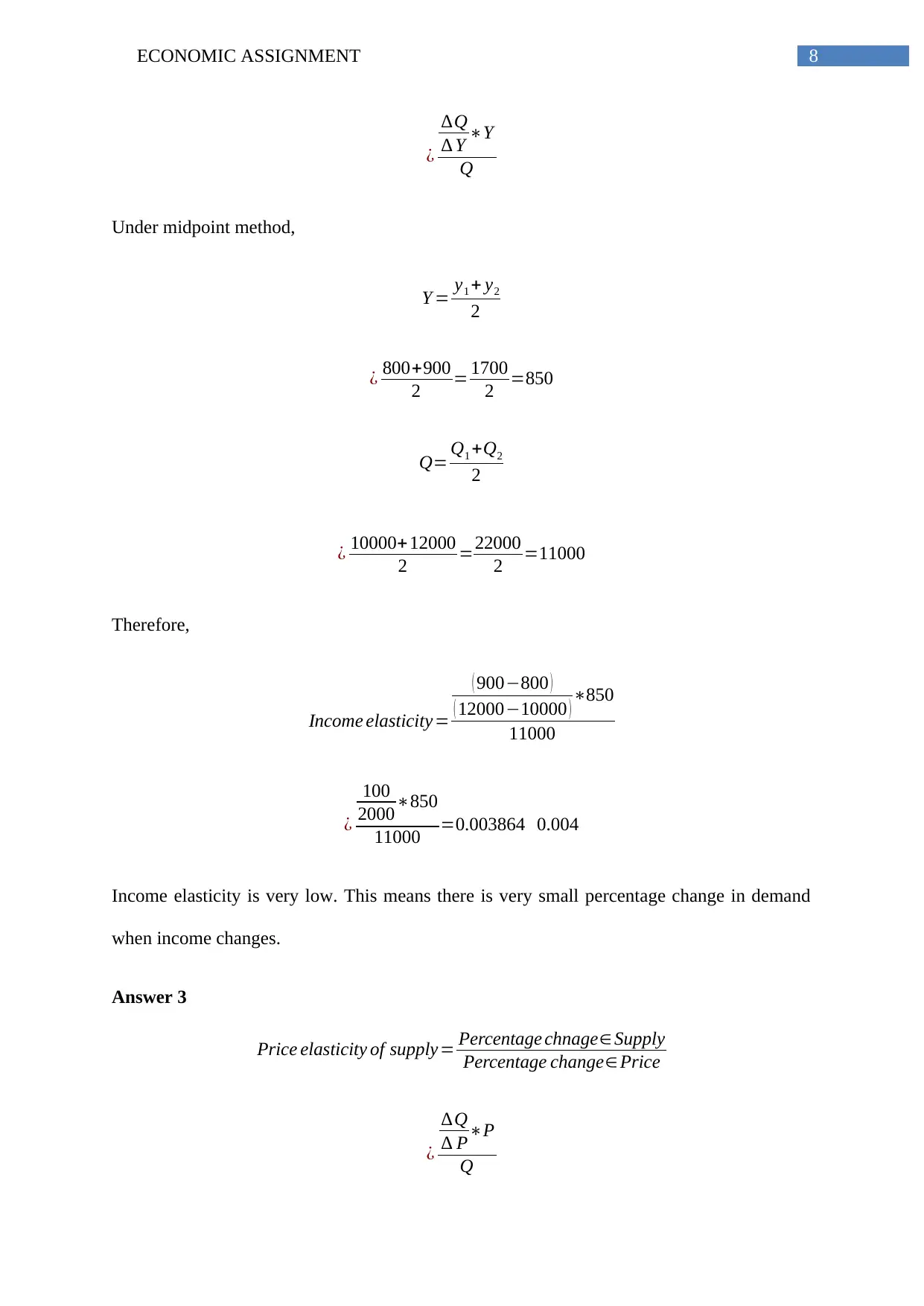
8ECONOMIC ASSIGNMENT
¿
∆Q
∆ Y ∗Y
Q
Under midpoint method,
Y = y1 + y2
2
¿ 800+900
2 = 1700
2 =850
Q= Q1 +Q2
2
¿ 10000+12000
2 =22000
2 =11000
Therefore,
Income elasticity=
( 900−800 )
( 12000−10000 ) ∗850
11000
¿
100
2000∗850
11000 =0.003864 0.004
Income elasticity is very low. This means there is very small percentage change in demand
when income changes.
Answer 3
Price elasticity of supply= Percentage chnage∈ Supply
Percentage change∈Price
¿
∆Q
∆ P∗P
Q
¿
∆Q
∆ Y ∗Y
Q
Under midpoint method,
Y = y1 + y2
2
¿ 800+900
2 = 1700
2 =850
Q= Q1 +Q2
2
¿ 10000+12000
2 =22000
2 =11000
Therefore,
Income elasticity=
( 900−800 )
( 12000−10000 ) ∗850
11000
¿
100
2000∗850
11000 =0.003864 0.004
Income elasticity is very low. This means there is very small percentage change in demand
when income changes.
Answer 3
Price elasticity of supply= Percentage chnage∈ Supply
Percentage change∈Price
¿
∆Q
∆ P∗P
Q
⊘ This is a preview!⊘
Do you want full access?
Subscribe today to unlock all pages.

Trusted by 1+ million students worldwide
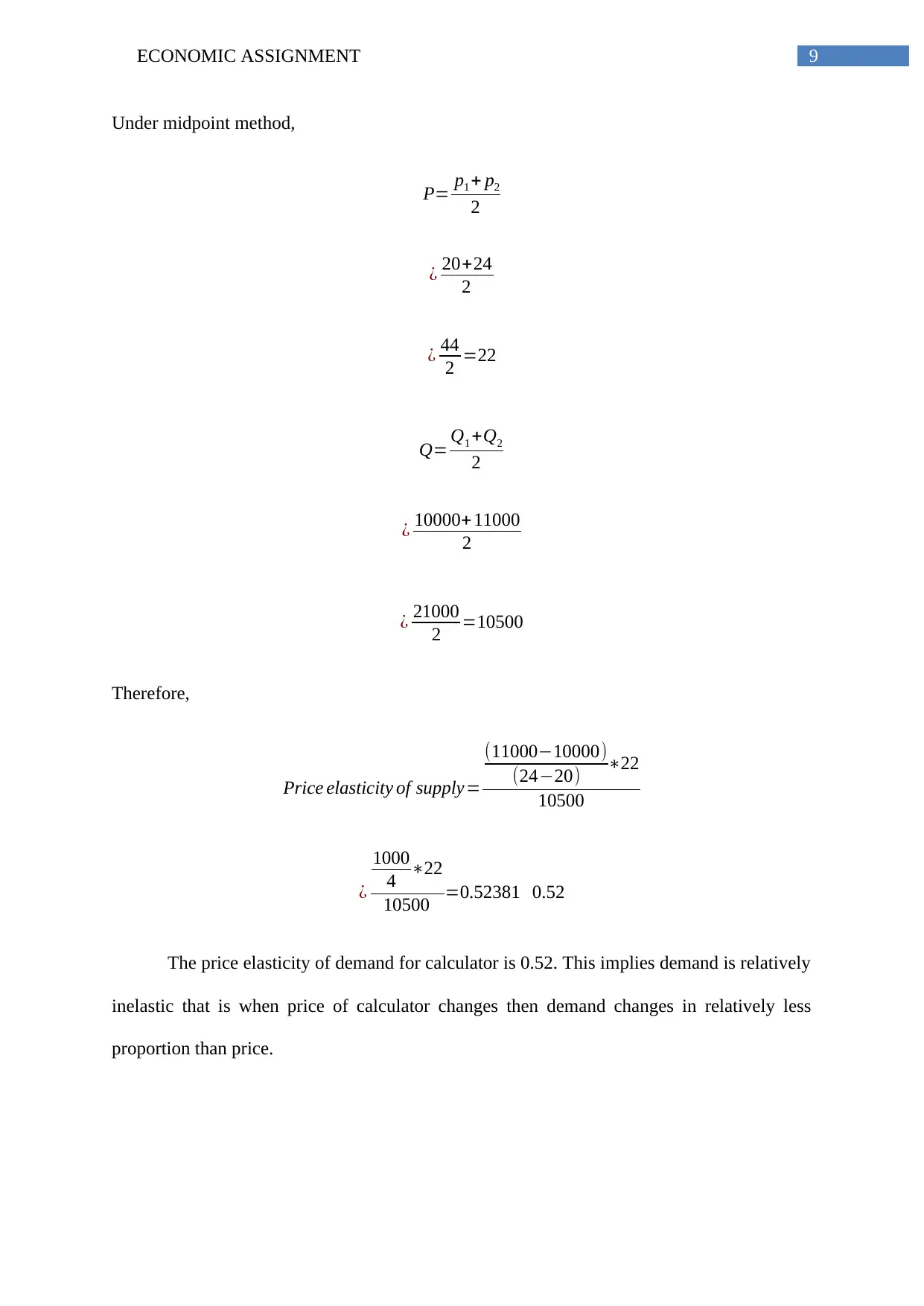
9ECONOMIC ASSIGNMENT
Under midpoint method,
P= p1 + p2
2
¿ 20+24
2
¿ 44
2 =22
Q= Q1 +Q2
2
¿ 10000+ 11000
2
¿ 21000
2 =10500
Therefore,
Price elasticity of supply=
(11000−10000)
(24−20) ∗22
10500
¿
1000
4 ∗22
10500 =0.52381 0.52
The price elasticity of demand for calculator is 0.52. This implies demand is relatively
inelastic that is when price of calculator changes then demand changes in relatively less
proportion than price.
Under midpoint method,
P= p1 + p2
2
¿ 20+24
2
¿ 44
2 =22
Q= Q1 +Q2
2
¿ 10000+ 11000
2
¿ 21000
2 =10500
Therefore,
Price elasticity of supply=
(11000−10000)
(24−20) ∗22
10500
¿
1000
4 ∗22
10500 =0.52381 0.52
The price elasticity of demand for calculator is 0.52. This implies demand is relatively
inelastic that is when price of calculator changes then demand changes in relatively less
proportion than price.
Paraphrase This Document
Need a fresh take? Get an instant paraphrase of this document with our AI Paraphraser
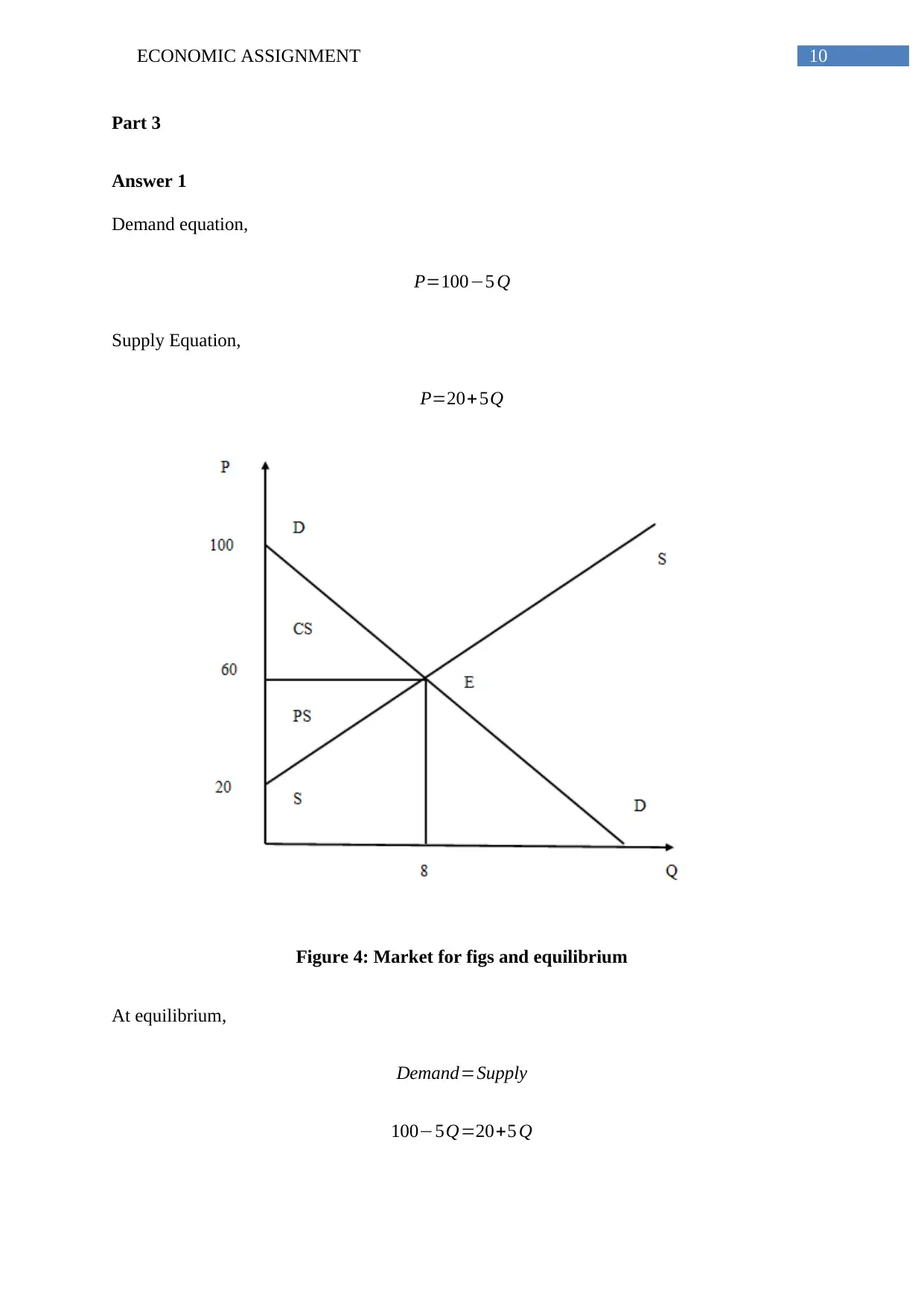
10ECONOMIC ASSIGNMENT
Part 3
Answer 1
Demand equation,
P=100−5 Q
Supply Equation,
P=20+5Q
Figure 4: Market for figs and equilibrium
At equilibrium,
Demand=Supply
100−5Q=20+5 Q
Part 3
Answer 1
Demand equation,
P=100−5 Q
Supply Equation,
P=20+5Q
Figure 4: Market for figs and equilibrium
At equilibrium,
Demand=Supply
100−5Q=20+5 Q
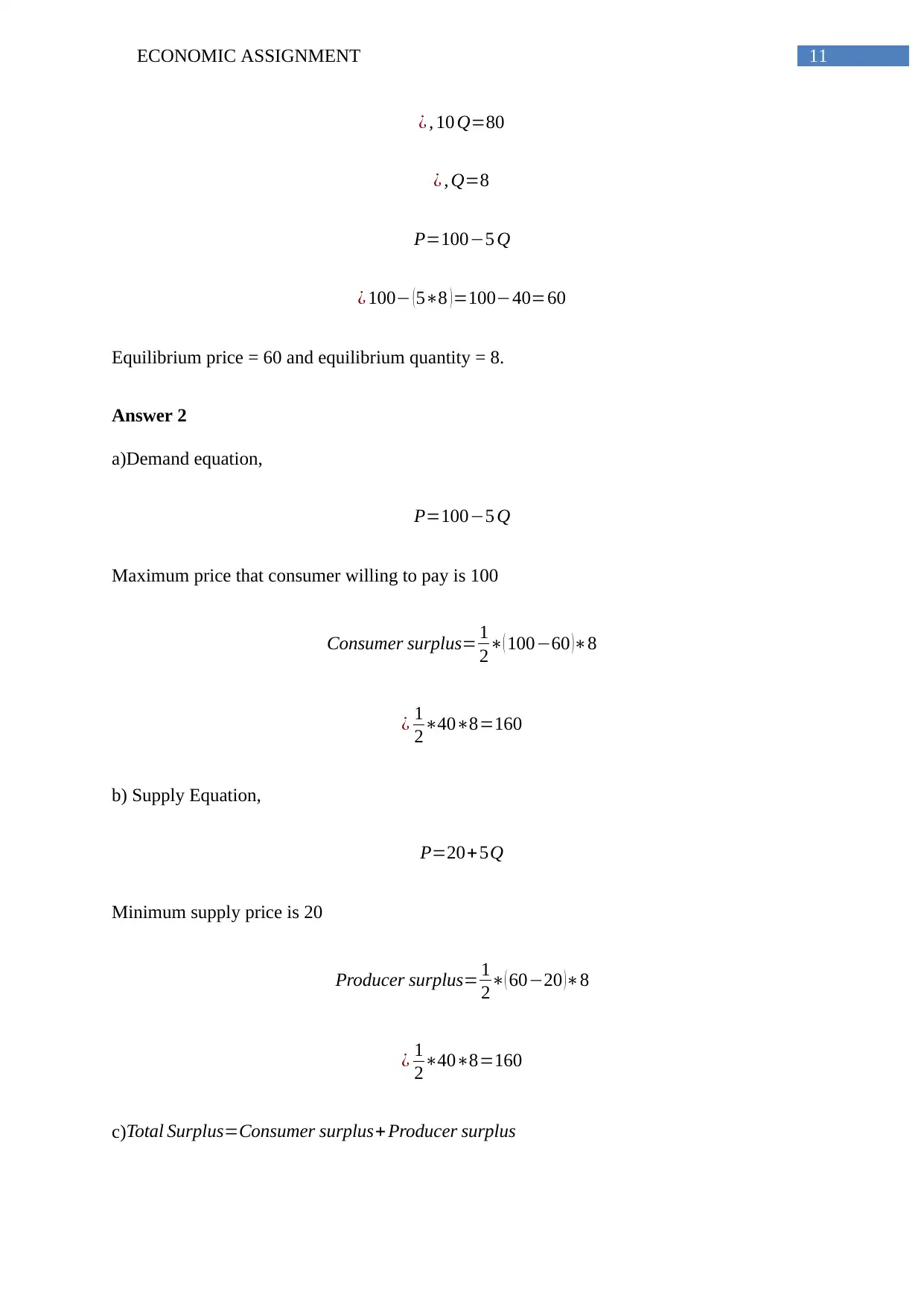
11ECONOMIC ASSIGNMENT
¿ , 10 Q=80
¿ , Q=8
P=100−5 Q
¿ 100− (5∗8 )=100−40=60
Equilibrium price = 60 and equilibrium quantity = 8.
Answer 2
a)Demand equation,
P=100−5 Q
Maximum price that consumer willing to pay is 100
Consumer surplus= 1
2∗( 100−60 )∗8
¿ 1
2∗40∗8=160
b) Supply Equation,
P=20+5Q
Minimum supply price is 20
Producer surplus= 1
2∗( 60−20 )∗8
¿ 1
2∗40∗8=160
c)Total Surplus=Consumer surplus+ Producer surplus
¿ , 10 Q=80
¿ , Q=8
P=100−5 Q
¿ 100− (5∗8 )=100−40=60
Equilibrium price = 60 and equilibrium quantity = 8.
Answer 2
a)Demand equation,
P=100−5 Q
Maximum price that consumer willing to pay is 100
Consumer surplus= 1
2∗( 100−60 )∗8
¿ 1
2∗40∗8=160
b) Supply Equation,
P=20+5Q
Minimum supply price is 20
Producer surplus= 1
2∗( 60−20 )∗8
¿ 1
2∗40∗8=160
c)Total Surplus=Consumer surplus+ Producer surplus
⊘ This is a preview!⊘
Do you want full access?
Subscribe today to unlock all pages.

Trusted by 1+ million students worldwide
1 out of 17
Related Documents
Your All-in-One AI-Powered Toolkit for Academic Success.
+13062052269
info@desklib.com
Available 24*7 on WhatsApp / Email
![[object Object]](/_next/static/media/star-bottom.7253800d.svg)
Unlock your academic potential
Copyright © 2020–2025 A2Z Services. All Rights Reserved. Developed and managed by ZUCOL.




